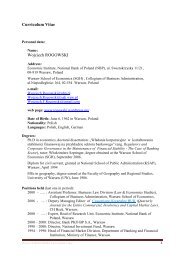EMERGING
Emerging Markets:
Emerging Markets:
Create successful ePaper yourself
Turn your PDF publications into a flip-book with our unique Google optimized e-Paper software.
<strong>EMERGING</strong> MARKETS:<br />
A Review of Business and Legal Issues<br />
technology casts doubt on the whole system of international law with its geographical<br />
territoriality doctrine. For instance, a criminal being geographically situated in China or<br />
Russian Federation can perpetrate a bank system in the U.S., or break the computer network<br />
in France and send viruses to its users, or place information that contain child pornography on<br />
the website that geographically is situated in Spain (let us also take into account that this site<br />
can be accessed by the indefinite number of Internet user from different countries of the<br />
world). In these examples that routinely take place in the virtual environment cybercriminals<br />
possessing certain practical skill can perpetrate targets in other countries not even leaving<br />
their homes. The offender and actual targets are separated by great distances, and the only<br />
connection between them is the network that binds its users.<br />
So what should be considered the place of perpetration of the cybercrime or, in other<br />
words, how can we define its territorial element?<br />
In general theory of Criminal Law a place of perpetration is understood as an objective<br />
category that represents a basis for application of territorial jurisdiction of the state. The last<br />
relies on the territorial supremacy of the state, which lies in its sole right to exercise<br />
jurisdiction, including criminal jurisdiction, over its territory, if other is not provided in the<br />
norms of International Law or in its international agreements. By general rule the place of<br />
perpetration is defined as the territory where harmful activity took place and where harmful<br />
consequences happened, or where accessories to a crime acted 1 . With regard to cybercrimes,<br />
harmful actions and results frequently take place at the very least in two countries, which will<br />
have an equal right to prosecute an illegal conduct (for example, a criminal cracks a server in<br />
another country and steals personal information of its users) 2 . But it seems almost impossible<br />
to identify a geographical place of perpetration in cases of computer viruses’ distribution 3 or<br />
1 Blum M.I. Effect of Soviet Criminal Law in Space. – Riga, 1974. – P. 133.<br />
2 In these fairly straight forwarded cases we do not take into account that a criminal might use Internet servers<br />
that are geographically situated in the third countries for committing a crime.<br />
3 For instance in 2000 notorious virus “ILOVEYOU” cloaked itself with an e-mail message and once opened<br />
rapidly spread worldwide, causing billions of dollars in damage and halting corporate networks. Causing<br />
damage to computer information of the victim it redirected Microsoft Internet Explorer surfers to a<br />
predetermined website where a separate program scanned the victim’s computer for passwords and log-in<br />
names. After this the virus sent a copy of itself to every name in the user’s address book, overloading computer<br />
Page 86 Volume 1, April 2009




